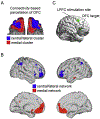Causal investigations into orbitofrontal control of human decision making
- PMID: 32864400
- PMCID: PMC7448682
- DOI: 10.1016/j.cobeha.2020.06.013
Causal investigations into orbitofrontal control of human decision making
Abstract
Although it is widely accepted that the orbitofrontal cortex (OFC) is important for decision making, its precise contribution to behavior remains a topic of debate. While many loss of function experiments have been conducted in animals, causal studies of human OFC function are relatively scarce. This review discusses recent causal investigations into the human OFC, with an emphasis on advances in network-based brain stimulation approaches to indirectly perturb OFC function. Findings show that disruption of human OFC impairs decisions that require mental simulation of outcomes. Taken together, these results support the idea that human OFC contributes to decision making by representing a cognitive map of the task environment, facilitating inference of outcomes not yet experienced. Future work may utilize similar non-invasive approaches in clinical settings to mitigate decision making deficits in neuropsychiatric disorders.
Conflict of interest statement
Conflict of interest statement The authors declare no conflict of interest.
Figures


Similar articles
-
Targeted Stimulation of an Orbitofrontal Network Disrupts Decisions Based on Inferred, Not Experienced Outcomes.J Neurosci. 2020 Nov 4;40(45):8726-8733. doi: 10.1523/JNEUROSCI.1680-20.2020. Epub 2020 Oct 13. J Neurosci. 2020. PMID: 33051355 Free PMC article.
-
Functional specialization of medial and lateral orbitofrontal cortex in inferential decision-making.iScience. 2024 May 17;27(6):110007. doi: 10.1016/j.isci.2024.110007. eCollection 2024 Jun 21. iScience. 2024. PMID: 38868183 Free PMC article.
-
Targeted Stimulation of Human Orbitofrontal Networks Disrupts Outcome-Guided Behavior.Curr Biol. 2020 Feb 3;30(3):490-498.e4. doi: 10.1016/j.cub.2019.12.007. Epub 2020 Jan 16. Curr Biol. 2020. PMID: 31956033 Free PMC article.
-
The role of orbitofrontal cortex in decision making: a component process account.Ann N Y Acad Sci. 2007 Dec;1121:421-30. doi: 10.1196/annals.1401.023. Epub 2007 Sep 10. Ann N Y Acad Sci. 2007. PMID: 17846161 Review.
-
Rodent medial and lateral orbitofrontal cortices represent unique components of cognitive maps of task space.Neurosci Biobehav Rev. 2020 Jan;108:287-294. doi: 10.1016/j.neubiorev.2019.11.009. Epub 2019 Nov 16. Neurosci Biobehav Rev. 2020. PMID: 31743727 Review.
Cited by
-
Computationally Informed Interventions for Targeting Compulsive Behaviors.Biol Psychiatry. 2023 Apr 15;93(8):729-738. doi: 10.1016/j.biopsych.2022.08.028. Epub 2022 Sep 7. Biol Psychiatry. 2023. PMID: 36464521 Free PMC article. Review.
-
Multi-scale neural decoding and analysis.J Neural Eng. 2021 Aug 16;18(4):10.1088/1741-2552/ac160f. doi: 10.1088/1741-2552/ac160f. J Neural Eng. 2021. PMID: 34284369 Free PMC article. Review.
-
To be specific: The role of orbitofrontal cortex in signaling reward identity.Behav Neurosci. 2021 Apr;135(2):210-217. doi: 10.1037/bne0000455. Epub 2021 Mar 18. Behav Neurosci. 2021. PMID: 33734730 Free PMC article. Review.
References
-
- Franklin TR, Acton PD, Maldjian JA, Gray JD, Croft JR, Dackis CA, O’Brien CP, and Childress AR (2002). Decreased gray matter concentration in the insular, orbitofrontal, cingulate, and temporal cortices of cocaine patients. Biol. Psychiatry 51, 134–142. - PubMed
-
- Volkow ND, and Fowler JS (2000). Addiction, a disease of compulsion and drive: involvement of the orbitofrontal cortex. Cereb. Cortex 10, 318–325. - PubMed
-
- Nakao T, Okada K, and Kanba S (2014). Neurobiological model of obsessive-compulsive disorder: evidence from recent neuropsychological and neuroimaging findings. Psychiatry Clin. Neurosci 68, 587–605. - PubMed
Grants and funding
LinkOut - more resources
Full Text Sources
Other Literature Sources
